HSP HISTORY Blog |
Interesting Frederick, Maryland tidbits and musings .
|
 Snorunt Snorunt I want to start by saying I have not played Pokémon Go, and don’t ever see myself doing so. Like many of my generation, I was introduced to the “Poké posse” by my kids. This came in the form of trading cards, books, Nintendo DS games and the anime television cartoon. Since my initial viewing of the tv show, I have always harbored a strong dislike for the slightly overweight, yellow, rodent named Pikachu. This has come with my sons’ collective chagrin because Pikachu is universally regarded as the cutest, loveable and most popular of all the species in the Pokémon monster universe. I personally think that he lacks the allure and charisma of the famous animated mice of my childhood such as Mickey, Jerry, Mighty and the “cultural crossover” Speedy Gonzales. Maybe it’s Pikachu’s high pitched voice, or those rosy red (energy filled) cheeks, but I just don’t feel the love. Now Patrat and Snorunt are another story, I love those creatures! The latter resembles the Jaws movie logo regurgitating Girl Scout Thin Mint® cookies.  Loveable Grace the cat. Please refrain from the Hitler jokes, as she has an unfortunate birthmark. Loveable Grace the cat. Please refrain from the Hitler jokes, as she has an unfortunate birthmark. There’s certainly no denying that this new mobile game has been taking over the lives of both kids and adults alike during the past few weeks. While Pokémon Go has not pervaded my boys yet (at least at the time of this writing), one of our family pets may be into it, but I haven’t seen a phone used. The other night, Grace the cat traveled the yard and actually caught her first mouse, which she proceeded to bring into the house as a trophy. She then decided to take it up to my bedroom for all to see. I had to fight her to retrieve the dying creature, comfortably being held in said cat’s mouth. I succeeded, but was sadly disappointed to find only a hapless minute, brown mouse—and not one of the fat and yellow variety! I find it ironic that Pokémon Go mania has officially captivated the world, especially at a time when world leaders, military operatives and intelligence authorities are playing the real-life version of the app—desperately hunting for Pokémon monsters in the form of terrorists and potential terror threats hiding within our landscape. At the same time, its also interesting to note that Pokémon is a game rooted in "doing battle" and this is based on species classifications and characteristics. Wait a minute, isn't our world and country also embroiled in battle and "species classifications" with all the threatening rhetoric, hate mongering and the potential for race wars based on perceived stereotypes cast upon Muslim, Mexican, Middle Easterners, Blacks, Whites, police officers and political candidates. My earlier scathing comments regarding sweet little Pikachu, caption for Grace's picture and reference to Speedy Gonzales could certainly be seen as equally offensive and racist as well. Politics, fear, culture clash, human nature and ignorance are constants in today’s world. But more importantly, those realities of good and evil surround us every day, just like those creatures hunted for an enthusiast’s Pokédex. Now you’re certainly not here to hear me talk politics. I’m not interested in that either, but I am experienced in sharing local history and stories, while adding proper context from time to time.  Early German settlers, the backbone of Frederick County since 1748! Early German settlers, the backbone of Frederick County since 1748! So where am I going with all this? So where am I going with all this? In the realm of Frederick’s history, I have discovered parallel events that slightly resemble Pokémon Go, involving “Pokémon trainers” of early times. Specifically, I want to share three important time periods that involve public safety officials and their searches/quests for securing the “gym community” of Frederick over our near 270-year history. Unfortunately, (or in some cases fortunately) each involves capturing and detaining members of the ethnic group responsible for originally settling and growing Frederick—the Germans. THE AMERICAN REVOLUTION ERA Our first stop takes us to the time of the American Revolution. Frederick is often characterized as being very strong in supporting the fight for independence against Great Britain. From the 1765 Stamp Act Repudiation by the twelve immortal Frederick County court justices (the first known protest from a sanctioned government body) to leading patriots such as Thomas Johnson, Jr., John Hanson and Lawrence Everhart, our local citizenry provided leadership, soldiers, supplies and money. Well at least most of them did—actually all but seven it appears. Those who reportedly chose to do otherwise were Peter Suman, Casper Fritchie, Henry Schell, Adam Graves, Yost Plecker, John George Graves, and Nicholas Andrews. And with the exception of Andrews, these guys were all German.  Newspaper article appearing in the August 10, 1781 edition of the Pennsylvania Evening Post (Philadelphia, PA) Newspaper article appearing in the August 10, 1781 edition of the Pennsylvania Evening Post (Philadelphia, PA) The seven men I listed above were part of a Tory Loyalist plot to support the British war effort, recruit troops and liberate prisoners. Their plan was actually discovered by a spy/informant at Harmony who promptly notified the authorities. The men were arrested on July 25, 1780 and were given a trial in Frederick nearly a year later in June 1781. A special tribunal presided over the proceedings and was headed by Alexander Contee Hanson (son of John Hanson, our first president and namesake for a portion of Maryland route 50). The following verdict of this court appeared in the August 15, 1781 edition of the Pennsylvania Gazette: "At a special Court, lately held at Frederick-Town, Maryland, Peter Suman, Nicholas Andrews, John George Graves, Yost Plecker, Adam Graves, Henry Shell and Casper Fritchie were found guilty of high treason. Judge Hanson imposed the following sentence on them: You will be carried to the gaol of Frederick County, and there be drawn to the gallows of Frederick-Town and be hanged thereon; you shall be cut down to the earth alive, and your entrails shall be taken out, and burnt while you are yet alive; your head shall be cut off; your body shall be divided into four parts, and your head and quarters shall be placed where his Excellence the Governor shall appoint—So Lord have mercy upon your poor souls!"  It’s sometimes been said that four of the gents got off with the proverbial “slap on the wrist,” however this wasn’t exactly the case as their sentence was commuted to life with hard labor aboard a French man-o-war. Three of these men (brothers Adam and John George Graves, along with Nicholas Andrews) would settle in Nova Scotia in 1782, living out their lives in Canada. Unfortunately, things weren’t quite as rosy for Peter Suman, Yost Plecker and Caspar Fritchie. It is thought that their sentence were lessoned a bit as well, reduced to simple hangings for each member of this trio, and not the “full monty” of having their bodies drawn and quartered. While certainly indicative of sending a firm message to the populous, “entrails on display” are not a tourist draw for any community, not even Frederick.  Now, you can’t exactly classify them as early tourists, but we did have plenty of European visitors here in Frederick during the Revolutionary War period. However, these well-traveled individuals were not here by choice, rather they were imprisoned guests at what some should consider Frederick’s first downtown hotel and conference center—the Hessian Barracks. Originally referred to as the Frederick Barracks, this impressive combo of stone structures and adjacent grounds resulted from one of the first acts of the new Maryland General Assembly under local resident (and first-elected Maryland governor) Thomas Johnson, Jr. English soldiers under Gen. Burgoyne were lodged here in November 1780 through July 1781. And yes, these are the guys who can be blamed for getting our local Germans in trouble (and executed) with that loyalist plot involving a plan to free British prisoners. Anyway, these Redcoats left town under military escort heading for Boston and a sea voyage back home to England.  Hessians surrendering after the Battle of Yorktown (October 1781) Hessians surrendering after the Battle of Yorktown (October 1781) The “Barracks” would soon receive the name that has stood the test of time. This occurred when mercenary soldiers hailing from Germany’s Hesse region showed up. They had been employed, rather forced to fight by their own Duke. And they had to do it with their on again/off again enemy in England. They sailed over and fought under the British forces. Nearly 1,400 soldiers who had surrendered or were captured at the battle of Yorktown arrived here in February 1782. Most would spend the next 15 months in the posh confines, basically bored out of their minds and uncertain about transportation back home to their “mutter-land.” There are several accounts of many of these soldiers working on local farms and deserting, eventually many assimilated into life as Frederick Countians when released at the war’s end. Besides, Frederick sure had more than its share of pretty and available German girls around. THE CIVIL WAR ERA Interestingly, eighty years later in September 1862, two Frederick residents closely tied to the “German prisoner” events of the American Revolution would play mighty roles in a new conflict facing Frederick, both city and county. These individuals were neighbors living on West Patrick Street who doubled as outspoken Unionists and supporters of President Abraham Lincoln.  "Shoot if you must, this old gray head, but spare your country's flagge, she said." "Shoot if you must, this old gray head, but spare your country's flagge, she said." One such person was a 95-year-old woman whose last name came from being married to the son of executed Tory Loyalist plot conspirator, Caspar Fritchie. Although gaining international fame (thanks to the immense success of John Greenleaf Whittier’s poem), Frederick’s top Deutsche dame and flag-waver, Barbara Fritchie, continues to be investigated and scrutinized by “spoiled sport” historians like yours truly! The pen of Whittier gave posthumous fame to this German, while eradicating the shame of the Fritchie name during the Revolutionary War. Speaking of pens, one was regularly used across the street from her house, making a later hero (at least to historians, researchers and genealogists) out of a cranky, "busy-body" who certainly knew politics like nobody's business.  Assassination of Abraham Lincoln by John Wilkes Booth at Fords Theater (April 14, 1865) Assassination of Abraham Lincoln by John Wilkes Booth at Fords Theater (April 14, 1865) Jacob Engelbrecht was the son of one those Hessian soldiers who decided to “marry local,” and conduct his profession as a tailor. Although following in his father Conradt’s footsteps, Jacob is best known for his outspokenness and more so his writing, having kept a detailed diary from 1819 until his death in 1878. He was very proud of three things, his German cultural heritage, his hometown of Frederick, and his country, the United States of America. The American Civil War had lasting effects on Engelbrecht, but no single event was more poignant than what happened at the war's close in April 1865. At this time, Jacob Engelbrecht was serving as Frederick City’s mayor, and had the painful and solemn duty of notifying the residents of the death of his hero and the Union's savior, President Lincoln.  George Atzerold George Atzerold News of Lincoln’s death polarized Frederick as it did countless cities in the north. Immediately, a manhunt to find the president’s assassin had begun. John Wilkes Booth had not acted alone, as other associates were now being searched for and duly arrested. Engelbrecht and the nation would soon learn that one of the conspirators was a native of Germany—George Atzerodt. The 30 year-old Atzerodt had been born in Dörna (today part of Anrode, Germany) and came to the US in 1843 at the age of eight. As an adult, he conducted a carriage repair business in Port Tobacco, Maryland. Cowardice got the best of George Atzerodt before he was able to carry out his specific assignment of killing vice president Andrew Johnson on the infamous night of April 14. He fled Washington, DC the next day with the intent of reaching Germantown (Maryland) and the farm of his cousin Hartman Richter. He successfully reached his destination, where he had spent considerable time as a child, but had left a sordid trail of clues behind for authorities. Atzerodt was captured at the Richter farm while in the confines of his bed in the early morning hours of April 20th.  Monocacy Junction Monocacy Junction A man of Scottish ancestry had apprehended the German conspirator in Germantown. Sgt. Zachariah W. Gemmill of the First Delaware Cavalry is credited with capturing Atzerodt. Gemmil’s unit had been stationed at Monocacy Junction, just below Frederick when his commanding officer received a tip from a local farmer named James W. Purdum regarding a suspicious man being harbored at the Richter farm. Gemmill and six troopers brought Atzerodt, Hartman Richter and two other farmhands back to Monocacy Junction, where they would be placed on trains and delivered back to Washington under military guard. Gemmill would eventually get to split a $25,000 reward with his commanding officer Major E. R. Artman, his six privates and James W. Purdum. As for George Atzerodt, he and three other convicted conspirators (Mary Surratt, Lewis Powell, and David Herold) were hanged in Washington, DC on July 7, 1865. Atzerodt's last words were "May we all meet in the other world. God take me now." He did not die instantly; his neck did not break upon impact, and his body shuddered for several minutes before dying. Atzerodt is assumed to be interred in an unmarked grave within the District’s Glenwood Cemetery, the same cemetery that holds the body of Mary Quantrill in an unmarked grave. Quantrill (whose mother was German) was another Civil War flag-waving heroine like her one-time neighbor of Barbara Fritchie on Frederick’s West Patrick Street. Jacob Engelbrecht would document the execution in his diary on Friday, July the 7th, 1765. He listed Atzerodt and his co-conspirators by name and emphatically added: "Justice has at last overtaken the murderers. All right!"  American Guard overseeing former German soldiers doing farmwork American Guard overseeing former German soldiers doing farmwork World War II Era Nearly 80 years after Atzerodt’s execution, German born prisoners would make a return to Frederick. In the September of 1944, a former Civilian Conservation Corps camp used by men to construct Gambrill Park in 1933 would take on a new use. The location west of Frederick City adjacent the national pike (Route 40) became home to about 350 German Prisoners of War under the command of Captain Eugene Messner. The site was on a four-acre plot that formerly belonged to the Klein family farm. Today this is the site of a few residences, Summers Farm and adjacent businesses including the Weis supermarket, Bob Evans Restaurant and the Anderabi owned McDonald’s. Old Camp Road derives its name from those “old camps.” Local residents learned that a popular radio announcer had been arrested by FBI agents as a German alien. Assumptions immediately arose that Brandon Roberts (aka Heinzdieter Baron von Schoenermarck) was a spy, instead of an enthusiastic news reporter and disk jockey behind the turntable of WFMD. Robert’s “Your’s For the Asking” program usually aired on Saturday nights, but there would be an imminent change in programming for the upcoming weekend. 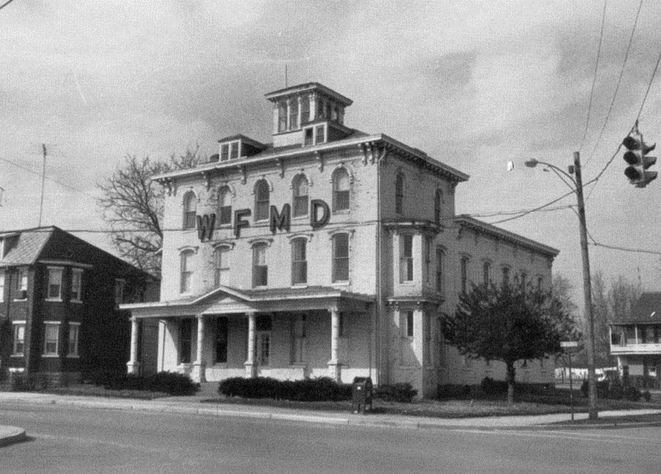 WFMD Radio station began broadcasting from the FSK Hotel, but eventually moved to the Groff House by the fountain at the intersection of N. Market and 7th streets. This was built by Capt. Joseph Groff in the late 1800s and operated as a hotel for many years. Groff was a colorful individual, proud of his German heritage and military service in the Civil War. He was one of the organizers of the Schutzen Gesellschaft (a German heritage social club interested in drinking beer and shooting guns) that met at Groff Park which would become eventually become the Hood College campus after his death. WFMD would later move to a location west of town atop Grove Hill.  Brandon Roberts, aka Heinzdieter Baron von Schoenermarck Brandon Roberts, aka Heinzdieter Baron von Schoenermarck “Heinz” von Schoenermarck was born in Heidelberg in 1918, but had come to the US with his widowed mother in May, 1929 at the age of ten. He and his mother resided in Manhattan on the Upper West Side, where he engaged in work as an actor. He can be found living with his mother in the 1940 census but would be soon after attending Harvard University in Cambridge, Massachusetts. Von Schoenermarck was hired by the Monocacy Broadcasting Company, owners of WFMD, after receiving recommendations from New York’s NBC School of Radio Announcers. He resided at 102 W. Third Street in Frederick. The story made front page news across the tri-state region, as well as garnering coverage in the distant papers of Amarillo, Texas and Thomasville, Georgia to name a few. The 23 year-old von Schoenermarck was taken before US Commissioner D. Angle Wolfinger in Hagerstown, and subsequently held on $10,000 bail while awaiting federal grand jury proceedings in Baltimore. The charge was that the young German announcer had failed to register as an enemy alien, and had been falsely contending that he was a US citizen, went by his stage name, and had failed to get government permission to travel within the country. Heinz von Schoenermarck was finally released from custody three months later in October. The FBI had found no wrongdoing or involvement in espionage on his part. Heinzdieter von Schoenermarck was officially naturalized as a US citizen on February 10, 1947 in Baltimore. His mother would soon follow suit. After the Frederick incident in 1942, the one-time “presumed” felon hit the high seas as a first-mate and entertainer on various yachts and cruise ships. He would do this for eight years. Like those Hessian Germans, Heinz would marry a local girl from Frederick, proving once again that they are irresistible. Her name was Margaret Elizabeth “Betsy” Herbert. They married in September 1950 and lived out their life together back in New York. My research on them was much like a game of Pokémon Go as I see glimmers of both in public records and ancestry files, but I haven’t been able to fully catch either. I was only able to "catch" bits and pieces of information appearing in online databases. The von Schoenermarcks raised their family in Sea Cliff, NY on Long Island, likely their final residence. I also found a lone reference to Heinzdieter in an AP story that identified him as working as an educator with the New York Botanical Gardens in the 1970’s. I am pretty certain he passed away in the late 1990’s. Betsy von Schoenermarck died in Oyster Bay, Long Island (NY) in 2008. Her body was returned home to Frederick County and she is buried in Middletown’s Zion Lutheran Cemetery with members of her Herbert family. In closing, I don't know how I merged Pokémon with countless imprisoned, executed and exploited Germans connected to our community. It's amazing how cyclical history really is....but please don't expect me to write anything on Schifferstadt, Fasnacht or Scherenschnitte for a good long while. History Shark Productions presents: Chris Haugh's "Frederick History 101" Are you interested in Frederick history? Want to learn more from this award-winning author and documentarian? Check out his latest, in-person, course offering: Chris Haugh's "Frederick History 101," with a 4-part/week course on Tuesday evenings in late August/early September, 2023 (Aug. 22, 29 & Sept 5, 12). These will take place from 6-8:30pm at Mount Olivet Cemetery's Key Chapel. Cost is $79 (includes 4 classes and 10 hours of local history).
For more info and course registration, click the button below! (More courses to come)
4 Comments
 As we embark on the most popular day and week, of summer, I wanted to look back at Frederick, Maryland and its relationship to the July 4th holiday. For those on vacation, and others hosting or attending a friendly barbecue, Independence Day is generally characterized by the other 3 “R’s”: relaxation, reflection and revelry. Some have labeled July 4th, “The Sunday of the Nation.” The word that best sums up the feeling on this day should be contentment—content by having freedom, possessing unalienable rights and just plain being proud to be an American. And many times such as this year, additional contentment comes with having a three-day weekend to boot. It’s ironic that this holiday has roots going back to the specific day in 1776 where the mood of the general populous was one of discontent. The people of Frederick County, Maryland, and countless inhabitants of the other 12 colonies were not pleased with their governance under Great Britain’s King George III, son of our county/city namesake—Frederick Louis, Prince of Wales (1707-1751).  As a matter of fact, discontentment in Frederick County can be traced back to July, 1765 when word had reached America that King George would soon be instituting a tax on stamped paper in the coming fall. This blatant example of “taxation without representation” angered many, but perhaps none more than our famed “12 Immortals,” the county court justices of Frederick County headed by William Beatty. In late November (1765), they repudiated Britain’s Stamp Act and carried on the business of their court without using the newly required stamped parchment. This is considered the first formal protest against the crown by an official governmental body in the colonies. If the Battle of Lexington and Concord is considered “the shot heard ‘round the world,” then the 1765 Stamp Act Repudiation by the Frederick County justices can be considered the first “verbal shot.” If anything else, our lesser heralded “Paper Soiree” helped influence Bostonians to carry out another protest eight years later. This, of course, was the Boston Tea Party of 1773.
 William W. Fleming and his well-marked tobacco haven (circa 1893). William W. Fleming and his well-marked tobacco haven (circa 1893). Interestingly, I found July 4th to be the birthday of Mayor Fleming’s late father, a local physician. Could there be some subliminal reason reaching back into the mayor’s childhood, possibly associated with having to be silent or reverent on this sacred date? Could the mayor have had an aversion to pyrotechnics, or was there a fear of loud sounds? Again, another irony lies in the old adage "Where there’s smoke, there’s fire," as the name Fleming (at the time)was synonymously associated with a popular tobacco and snuff store located adjacent Frederick’s square corner in the first block of West Patrick. This was operated by a William W. Fleming, likely a cousin, but I haven’t been able to attain this relationship. (NOTE: I also am curious as to the familial connection to today’s Fleming Avenue, a very popular locale to spend July 4th.) In essence, this was the 4th of July equivalent of the movie Footloose. Many townspeople were livid, especially wayward teens and ornery children, not to mention more than a few uppity adults. Now in Mayor Fleming’s defense, this particular Fourth fell on a Sunday, aka Lord’s Day. Some decorum needed to be shown churchgoers, because firecracker hijinx was not just something that happened after dusk as we know today. In addition, things had gotten wildly out of hand over the years with the high frequency of firework-related accidents, maimings, etc., especially involving young people. The newspapers over the years could always count on these stories to help fill content. Fire risk was also a reality, and the mayor had been working hard for months on fire-related ordinances and strengthening support for the volunteer fire departments of Frederick. Lastly, who needs people shooting off firearms in town, especially after a long day of celebratory alcoholic libations? 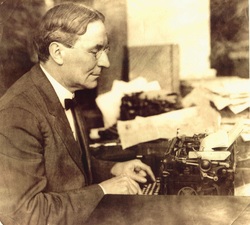 Folger McKinsey, "the Bentztown Bard" wrote for the Frederick News. The Elkton (MD) native gained greater fame with the Baltimore Sun, for which he worked for over 40 years until his death in 1950. Folger McKinsey, "the Bentztown Bard" wrote for the Frederick News. The Elkton (MD) native gained greater fame with the Baltimore Sun, for which he worked for over 40 years until his death in 1950. To the average Joe “Son of Liberty,” this rationale seemed to buck tradition, looking more like an infringement on God-given rights. Isn’t there a Constitutional amendment providing for the right for American citizens to spend Independence Day doing whatever the heck they pleased to show their patriotic devotion to flag and country? The famed "Bentztown Bard" Folger McKinsey wrote in the Daily News another signature "tongue in cheek ditty": "I believe in letting the eagle scream On the glorious Fourth of July; As firmly I believe that mankind, Would perish 'twere not for pie." 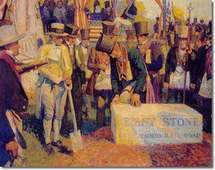 July 4th, 1828 Baltimore & Ohio Railroad groundbreaking ceremony in Baltimore with Maryland's Charles Carroll of Carrollton, the last surviving signer of the Declaration of independence. July 4th, 1828 Baltimore & Ohio Railroad groundbreaking ceremony in Baltimore with Maryland's Charles Carroll of Carrollton, the last surviving signer of the Declaration of independence. Now don’t get me wrong, the good far outweighed the bad when it came to July 4th. Most annual celebrations went off with a bang, and good times were had by all. One of the best took place on July 4, 1828 in which simultaneous groundbreakings were taking place in Baltimore and Georgetown respectively. These included the birth of two legendary transportation lines that would greatly impact Frederick commerce, agriculture and passenger travel. These were the Chesapeake & Ohio Canal and the Baltimore & Ohio Railroad. Both would reach Frederick in 1831.  Frederick Daily News (July 5, 1893) Frederick Daily News (July 5, 1893) While many flame-loving residents escaped to surrounding areas to shoot off fireworks and guns, the event at City Hall was well attended, and equally received. The stage was beautifully decorated in red, white and blue, and collection boxes were strategically placed at the theater’s entrance to receive donations for a proposed monument to Francis Scott Key. This would become a reality five years later. Jacob Rohrback, a leading Frederick lawyer, Freemason and member of the Philomathean Society said the following in his speech that July 4th night: “We shall take pride in teaching our children the principles upon which the nation of sovereign states are based, for we must remember that it is our children and our children’s children who are to inherit what comes after us.” That July 4th, Capt. Q. S. J, Beckley and his able corps of assistants of the Frederick Riflemen, celebrated the Fourth in grand style at the Frederick Fairgrounds. Among the amusements held, highlights of the day included a one-mile bicycle race around the track and a baseball game. In nearby Middletown, things were relatively quiet, save for a nice parade through town that afternoon. A like ordinance against explosives had been enforced, but the youngsters took to wearing grotesque masks and waving flags as they took march in the parade with their brethren. After reading an account of a young doctor attending a party in nearby Jefferson, I certainly have a new view on what was considered “fireworks fun” during the period. It appears that this gentleman was lured in by a flirtatious group of young ladies working in tandem with a group of young hooligans. The boys attached, and lit, a bundle of fireworks to the physician’s frock coat. Luckily he escaped injury, but I can surely think of safer and less stressful ways to celebrate the independence of our nation. Luckily things got back to normal, "July 4th wise" when Mayor Fleming left office in 1895. So in closing, I wish you and yours a very happy Fourth! But please think twice before shooting off your bottle rockets, cakes, and Roman candles this holiday as the ordinance is still in effect within the corporate boundaries of Frederick. You can still enjoy sparklers without repercussion, both literally and figuratively. While we can demonstrate the proper spirit of patriotism in many ways, take a few minutes to remember why we continue to have the right to celebrate such an incredible annual event and explain this to a young person. Not to mention “the self-evident truths” that most of us get a paid day off work and are entitled to all the hot dogs, hamburgers and apple pie we care to eat. Talk about being content. Now let's make some noise for all Frederick County's patriots, past and present! History Shark Productions presents: Chris Haugh's "Frederick History 101" Are you interested in Frederick history? Want to learn more from this award-winning author and documentarian? Check out his latest, in-person, course offering: Chris Haugh's "Frederick History 101," with a 4-part/week course on Tuesday evenings in late August/early September, 2023 (Aug. 22, 29 &Sept. 5, 12).These will take place from 6-8:30pm at Mount Olivet Cemetery's Key Chapel. Cost is $79 (includes 4 classes).
In addition to the lecture class above, four unique "Frederick History 101 Walking Tour-Classes" in Mount Olivet Cemetery will be led by Chris this summer. These are available for different dates (July 11 & 25th, Aug. 8th & 23rd). Cost $20 For more info and course registration, click the button below! (More classes to come) |
AuthorChris Haugh Archives
February 2024
Categories |
Proudly powered by Weebly


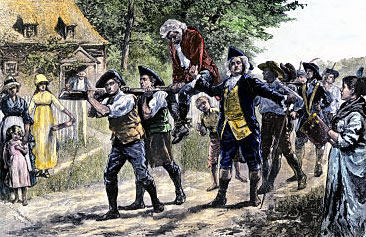
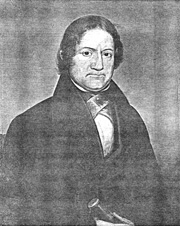















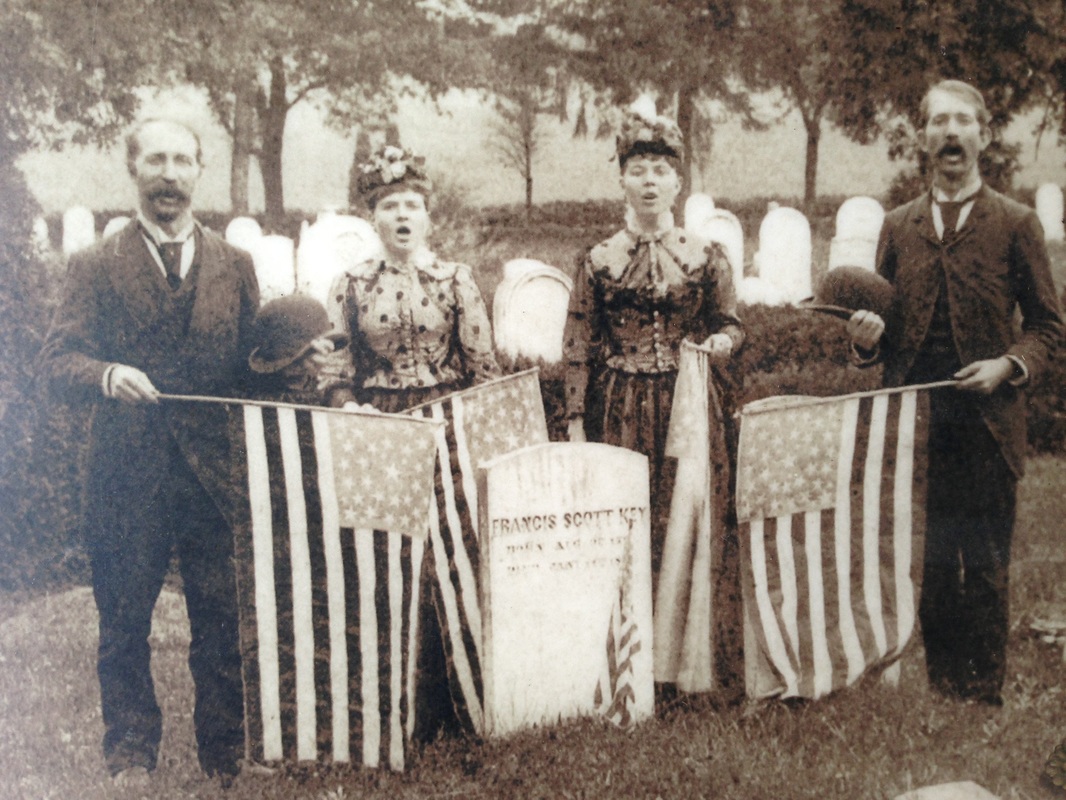
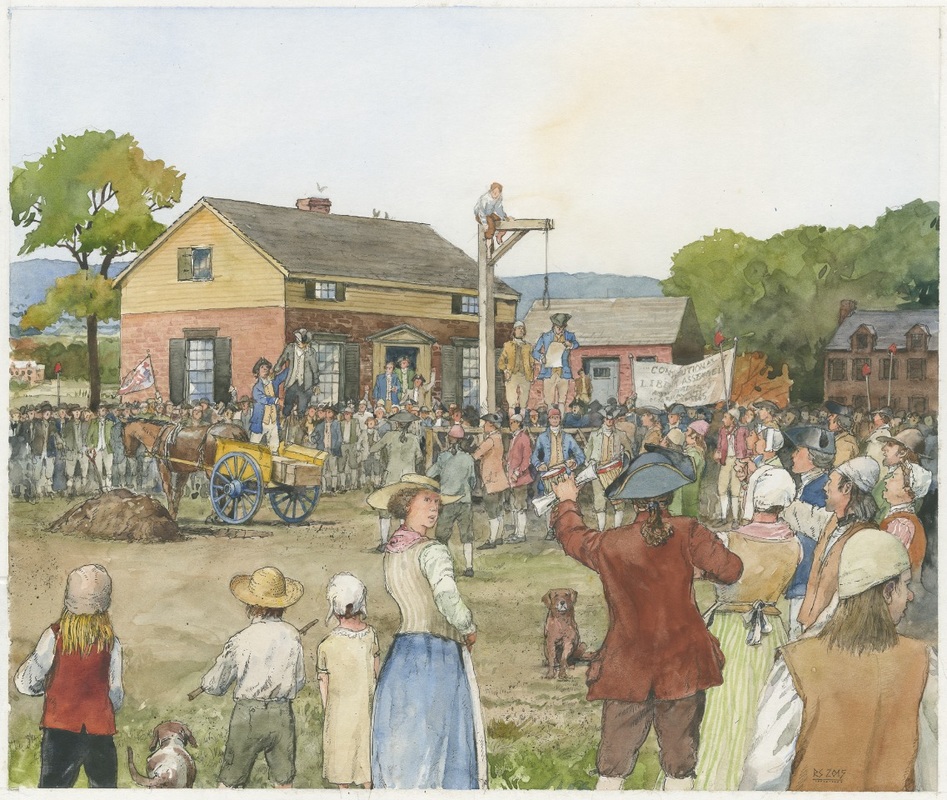
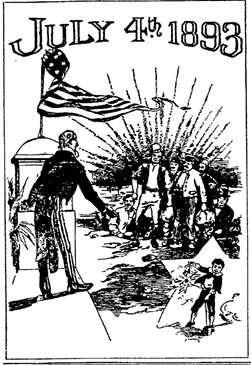



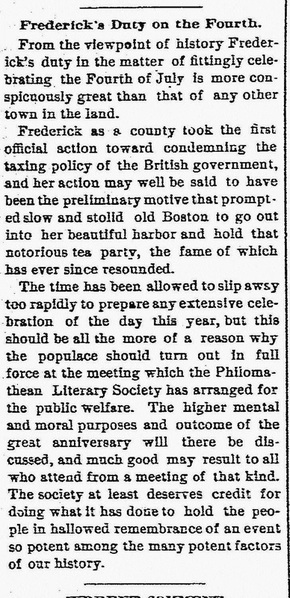







 RSS Feed
RSS Feed